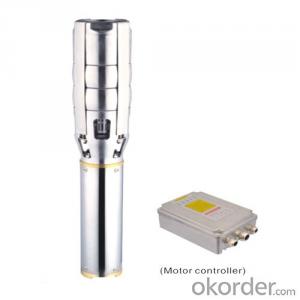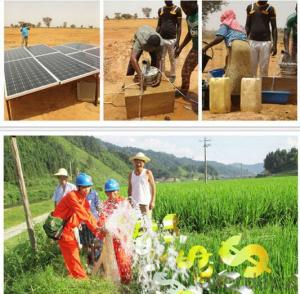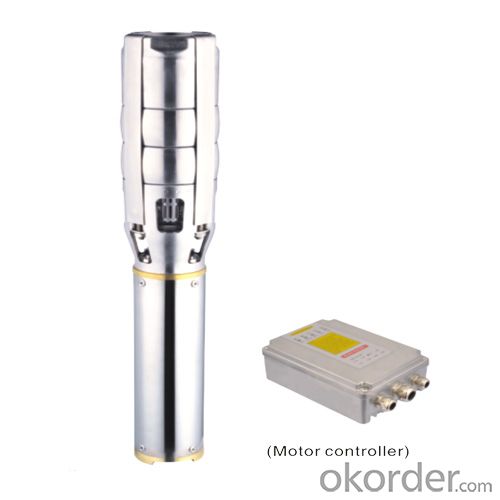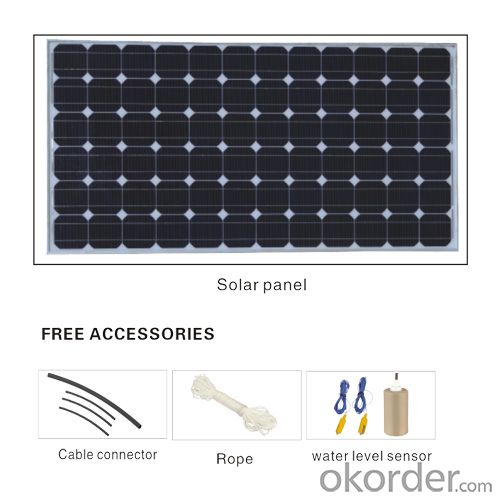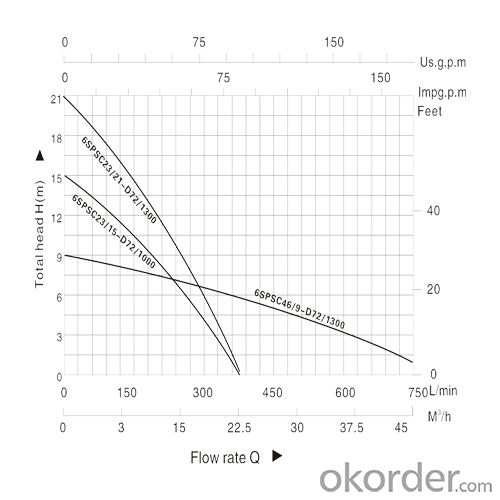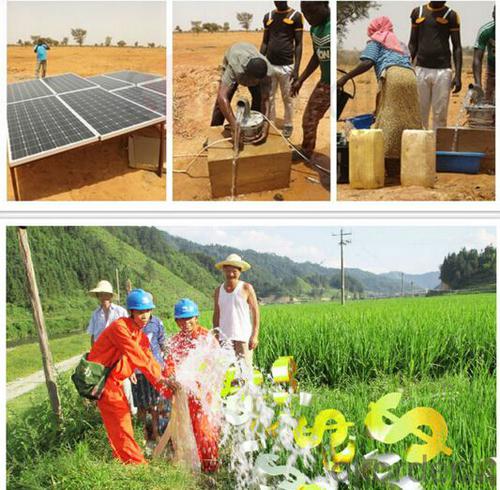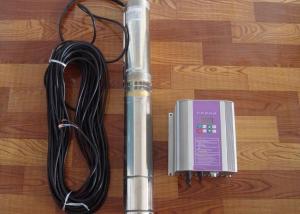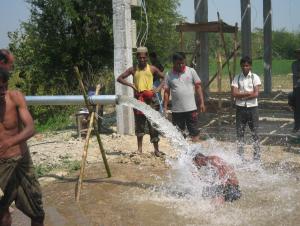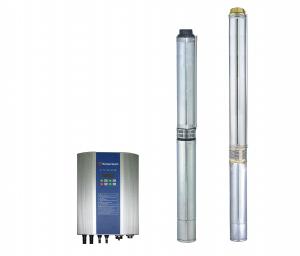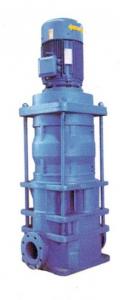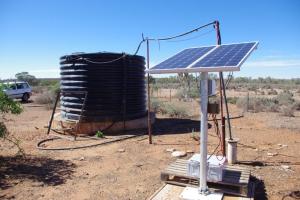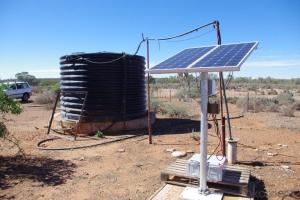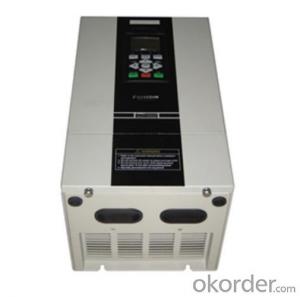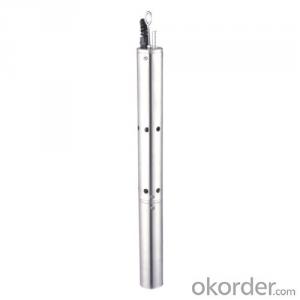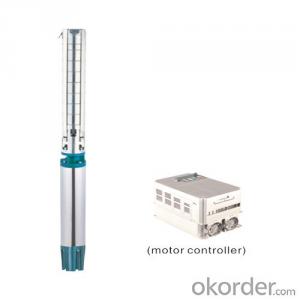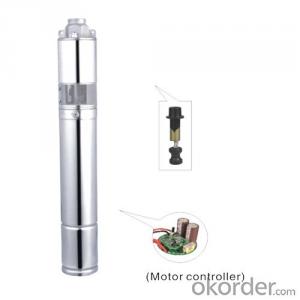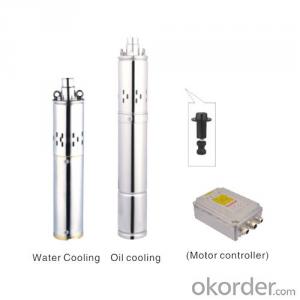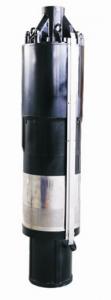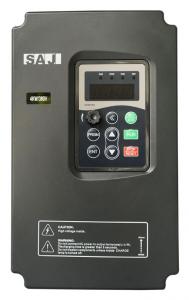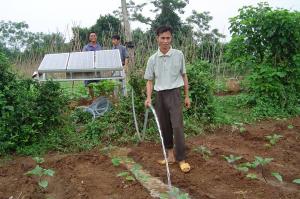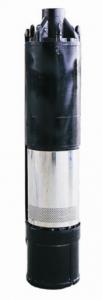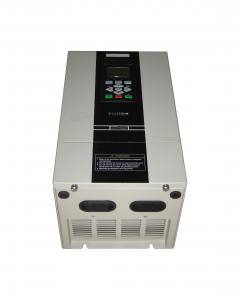Likou Solar Pump 6 SPSI Stainless Steel for Easy Install Wells with CE Certification
- Loading Port:
- Ningbo
- Payment Terms:
- TT OR LC
- Min Order Qty:
- 10 unit
- Supply Capability:
- 100000 unit/month
OKorder Service Pledge
OKorder Financial Service
You Might Also Like
Specifications
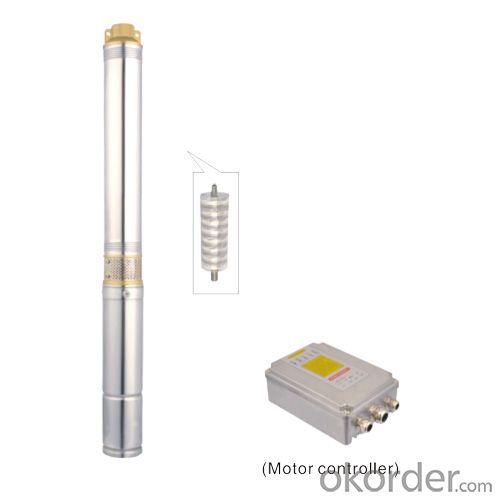
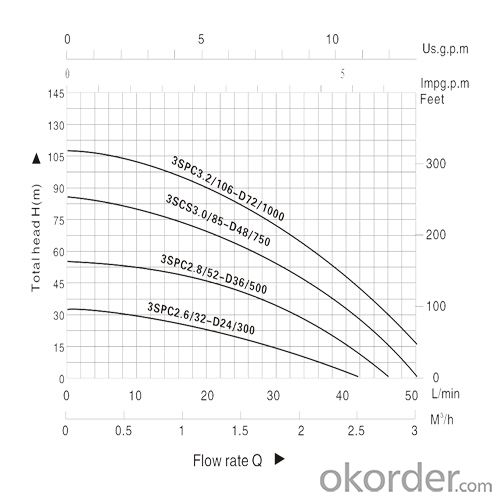
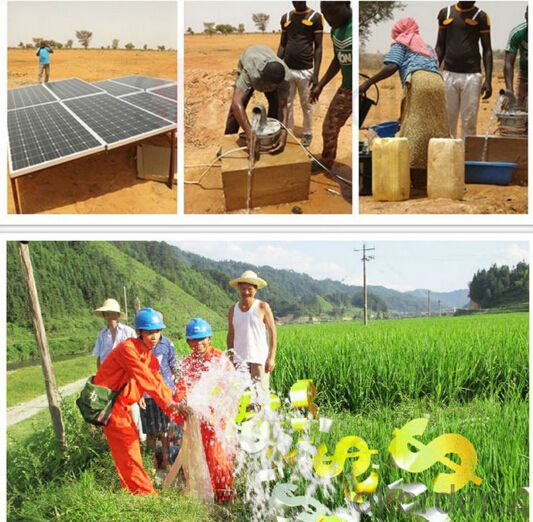
•Profile:
Adopt stainless steel casing, shaft core, coupling, water entry base and pump body (or copper alloy water entry base, pump body) to avoid rust or corrosion, stainless steel impeller and stainless steel blower inlet casing. New "floating style" structure of impeller avoids axial pressure to motor. With combination of motor and controller, the max efficiency is over 85%, raises 20% than the traditional AC one.
•Material:
1)Stainless steel casing, shaft core, coupling and pump body; copper alloy connecting, base; stainless steel impeller and stainless steel blower inlet casing.
2)Water immersion style stainless steel submersible motor; graphite bearings.
•Product Feature:
1)Compact structure,high-lift,noiseless,pollution-free; complete electrical protecting controller device, against under-voltage, over-voltage, over -flow, overload, waterless etc; automatic recovery; control ling water height as demand.
2)Easy installation, maintenance-free, safe and reliable.
Water depth: 1 -25m Max flow: 60m3/h
•Application:
1) These electric pumps series are workable within maximum head, as there are no restrictions of BDC. With the addition of high head, high efficiency and wide high efficiency zone, they are suitable for distance water irrigation, high efficiency of increasing oxygen on aquaculture, pumping water from deep well, gardening, fountain and etc.
•Working condition:
1)Non-corrosive water; the volume ratio of sand content no more than 5%o particle size less than 3mm.
2)Max medium temperature up to +40^; PH value remains 5-10.
3)Work close to the rated head and must be immersed in water.
•Motor Data
MODEL | Voltage | Power | Max.head (m) | Max.flow | OUTLET | GW | Dimension |
6SPSC23/1 5-D72/1 000 | 48-96 | 600-1200 | 15 | 23 | G3" | 16 | 150 |
6SPSC23/21 -D72/1 300 | 48-96 | 800-1500 | 21 | 23 | G3" | 16 | 150 |
6SPSC46/9-D72/1 300 | 48-96 | 800-1500 | 9 | 46 | G4" | 16 | 150 |
Product Description
Product Feature
Solar submersible pumps is the efficient equipment to extract groundwater in applications of agricultural irrigation, human and livestock water in plateau and mountain areas, etc.
1. Motor and shell made of stainless steel
2. Stainless steel shaft and coupling
3. High strength & wear resistance stainless steel impeller and diversion shell
4. Sand resistance, anti-rust, pollution-free, long life time
5. Small size, light and easy to ship
6. Easy installation and easy maintain
7. High efficient smart controller with multiple protections: over-temperature protection,
short-current protection, over-load and under-voltage protection. Safe and reliable to use.
Price includes pump with controller. Solar PV panels may be purchased separately.






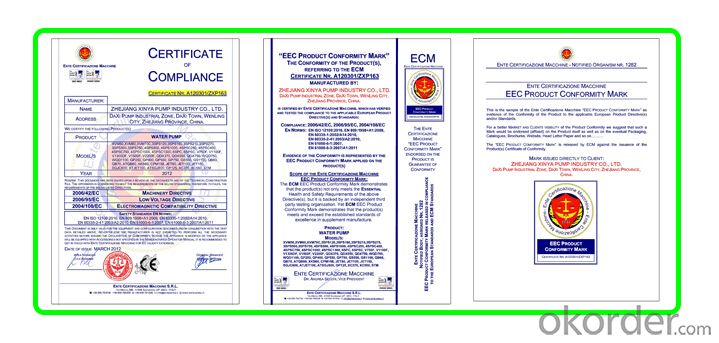
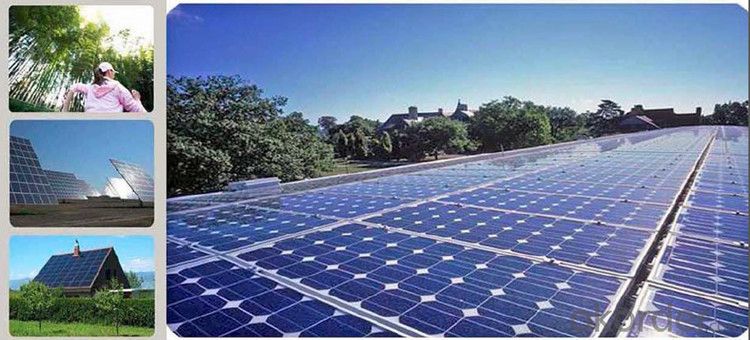
CNBMSOLAR is a world-leading and Vertical integrated manufacturer of high-performance with Silicon, Wafer, Cells,
Modules, which convert sunlight into electricity for residential, commercial, and utility-scale power generation.
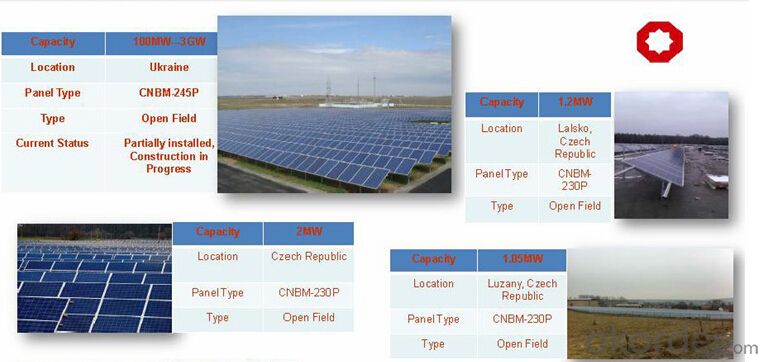
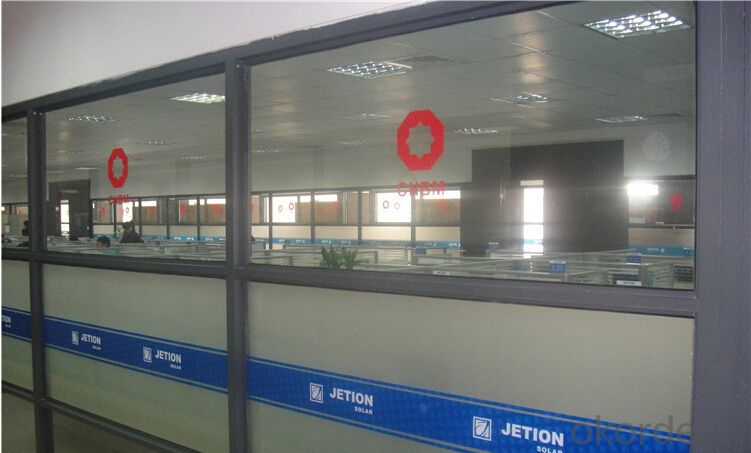
FAQ
Q1. When can I get the quotation?
We usually quote within 24 hours after we get your inquiry. If you are urgent to get the price, please send the message on trade manager or call us directly.
Q2. Can I buy one as sample?
Yes, of course. MOQ of solar pump is 1 piece. For the other kind of products (water pump, air compressor and welding machine), you need to pay all the fee when we make the sample.
Q3. Can you make OEM?
Yes, you can put your logo and brand on the box.
Q4. What is your main market?
Eastern Europe, Southeast Asia. Mid East, South America, Northern Europe.
- Q: What is the maximum depth at which a solar pump can extract water?
- The maximum depth at which a solar pump can extract water depends on various factors such as the capacity and power of the pump, the efficiency of the solar panels, and the availability of sunlight. However, in general, solar pumps are capable of extracting water from depths ranging from 100 to 500 feet (30 to 150 meters).
- Q: How long does it take for a solar pump to pay for itself in terms of energy savings?
- The payback period for a solar pump in terms of energy savings depends on various factors such as the initial cost of the pump, the amount of energy savings achieved, and the local electricity rates. On average, it can take anywhere from 2 to 7 years for a solar pump to pay for itself through energy savings.
- Q: Can a solar pump be used for water supply in aquaculture farms?
- Yes, a solar pump can be used for water supply in aquaculture farms. Solar pumps are an environmentally friendly and cost-effective solution for providing water to aquaculture farms. They can harness the energy from the sun to power the pump, eliminating the need for electricity or fuel. This makes them an ideal choice for remote or off-grid locations. Solar pumps can efficiently supply water for various aquaculture needs, including fish tanks, ponds, or recirculating systems, helping to maintain optimal water conditions for the aquatic life.
- Q: How much sunlight is needed to operate a solar pump effectively?
- The amount of sunlight needed to operate a solar pump effectively depends on various factors such as the size and efficiency of the solar panels, the power requirements of the pump, and the geographical location. In general, solar pumps require a certain level of sunlight to generate enough energy to power the pump and meet its operational needs. Most solar pumps are designed to work optimally with direct sunlight, which means that the panels should be exposed to the sun's rays at a 90-degree angle. This allows for maximum absorption and conversion of solar energy into electrical power. However, solar pumps can still function to some extent under partial sunlight or diffused light conditions. The efficiency and performance of the pump may be reduced, but it can still operate to a certain degree. The amount of sunlight required also varies depending on the power requirements of the pump. Higher power pumps may require more sunlight to generate enough energy, while smaller pumps may be able to operate effectively with less sunlight. Additionally, the geographical location plays a significant role in determining the amount of sunlight available. Regions with higher solar irradiation, such as those closer to the equator or with less cloud cover, will receive more sunlight and therefore allow solar pumps to operate more effectively. Conversely, areas with lower solar irradiation or frequent cloudy conditions may require larger solar panels or backup energy sources to ensure the pump operates efficiently. In summary, the amount of sunlight needed to operate a solar pump effectively depends on the size and efficiency of the solar panels, the power requirements of the pump, and the geographical location. While direct sunlight is ideal, solar pumps can still function to some extent under partial sunlight or diffused light conditions. It is important to consider these factors when determining the suitability of a solar pump for a specific application or location.
- Q: Can a solar pump be used for agricultural spraying or sprinkler systems?
- Yes, a solar pump can be used for agricultural spraying or sprinkler systems. Solar pumps use energy from the sun to power water pumps, making them an environmentally friendly and cost-effective option for various agricultural applications, including irrigation and sprinkler systems. These pumps can provide a reliable and sustainable water supply for efficient crop watering and maintenance.
- Q: Can a solar pump be used for water circulation in ponds or lakes?
- Yes, a solar pump can be used for water circulation in ponds or lakes. Solar pumps are designed to efficiently harness solar energy and convert it into power to run water circulation systems. They can help improve water quality, prevent stagnation, and promote a healthier environment for aquatic life in ponds or lakes.
- Q: Can a solar pump be used for water transfer between reservoirs or tanks?
- Yes, a solar pump can be used for water transfer between reservoirs or tanks. Solar pumps are designed to efficiently draw water from one source and transfer it to another, making them ideal for applications such as transferring water between reservoirs or tanks. They utilize solar energy to power the pump, eliminating the need for electricity and making them cost-effective and environmentally friendly solutions for water transfer.
- Q: What are the key components of a solar pump system?
- The key components of a solar pump system include solar panels, a controller, a pump, a storage tank or reservoir, and a network of pipes or hoses. The solar panels capture sunlight and convert it into electrical energy, which is then processed by the controller to power the pump. The pump, typically a submersible or surface pump, moves water from the source (such as a well or a river) to the storage tank or reservoir. The network of pipes or hoses facilitates the transportation of water from the pump to the desired location. Overall, these components work together to harness solar energy and provide a sustainable and efficient solution for pumping water.
- Q: Are there any government incentives or subsidies for installing a solar pump?
- Installing a solar pump is eligible for government incentives and subsidies. Governments worldwide recognize the significance of renewable energy and the advantages of utilizing solar power for water pumping systems. These incentives and subsidies are designed to promote the adoption of solar pumps as an eco-friendly and sustainable alternative to traditional systems. The availability of specific incentives and subsidies may vary depending on the country or region. However, they typically include financial aid, tax credits, grants, and low-interest loans. For instance, in the United States, the federal government provides a federal investment tax credit (ITC) that enables individuals and businesses to deduct a portion of their solar pump installation costs from their federal taxes. Some states may even offer additional incentives alongside the federal ITC. Moreover, international organizations like the World Bank offer funding and support for solar pump installations in developing nations. These initiatives aim to enhance access to clean water and boost agricultural productivity in areas with unreliable or nonexistent electricity supply. To obtain detailed information about the incentives and subsidies available in your area, it is recommended to consult local government agencies, energy departments, or renewable energy associations. By taking advantage of these government programs, individuals and businesses can significantly reduce the initial expenses of installing a solar pump while contributing to a more sustainable future.
- Q: Can a solar pump be used for mine dewatering?
- Yes, a solar pump can be used for mine dewatering. Solar pumps are an environmentally friendly and cost-effective option for pumping water out of mines. They use solar energy to power the pump, eliminating the need for electricity or fuel. Solar pumps have the capability to handle large volumes of water and can be customized to meet the specific requirements of mine dewatering. They are also highly reliable and require minimal maintenance. Additionally, using solar pumps for mine dewatering reduces the carbon footprint and dependency on fossil fuels, making it a sustainable solution for mining operations.
Send your message to us
Likou Solar Pump 6 SPSI Stainless Steel for Easy Install Wells with CE Certification
- Loading Port:
- Ningbo
- Payment Terms:
- TT OR LC
- Min Order Qty:
- 10 unit
- Supply Capability:
- 100000 unit/month
OKorder Service Pledge
OKorder Financial Service
Similar products
Hot products
Hot Searches
Related keywords
